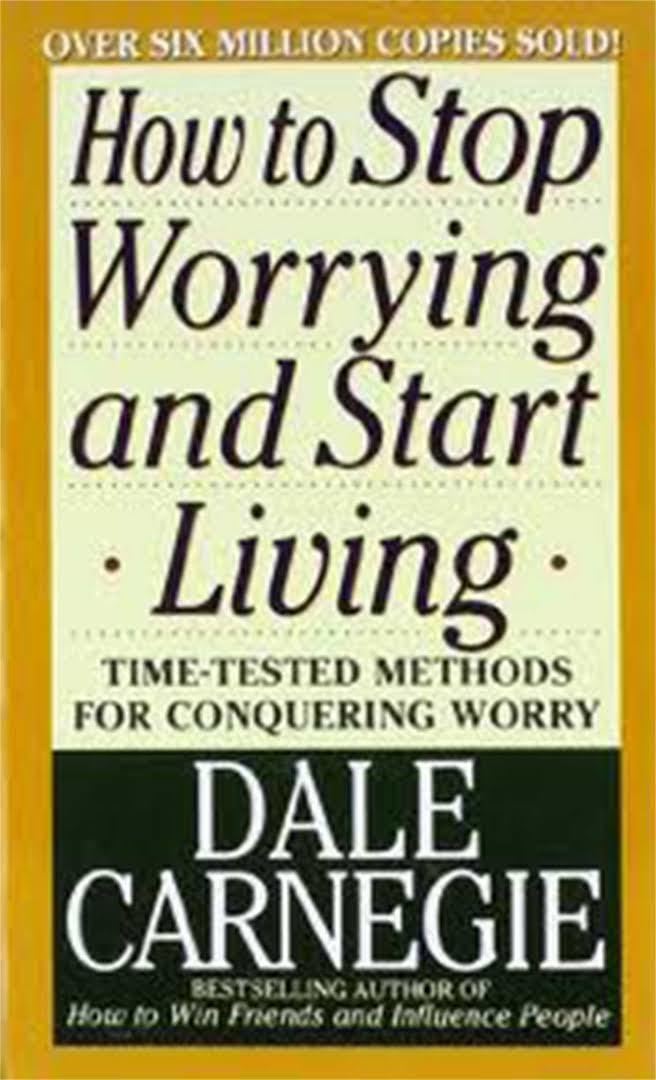8.8 /10 1 Votes8.8
Language English OCLC 203759 ISBN 0671035975 Country United States of America | 4.4/5 Barnes & Noble Publication date 1948 Pages 306 pp Originally published 1948 | |||||||||||||||||||||||||||||||||
 | ||||||||||||||||||||||||||||||||||
Publisher Simon and Schuster (1948) Similar Dale Carnegie books, Self-help books, Worry books | ||||||||||||||||||||||||||||||||||
How to stop worrying and start living by dale carnegie animated book review
How to Stop Worrying and Start Living is a self-help book by Dale Carnegie. It was first printed in Great Britain in 1948 by Richard Clay (The Chaucer Press), Ltd., Bungay Suffolk (S.B.N. 437 95083 2). It is currently published as a Mass Market Paperback of 352 pages by Pocket (Revised edition: September 15, 1990), ISBN 0-671-73335-4.
Contents
- How to stop worrying and start living by dale carnegie animated book review
- Sections
- Fundamental Facts You Should Know About Worry
- Basic Techniques In Analyzing Worry
- How to Break the Worry Habit Before It Breaks You
- Seven Ways to Cultivate A Mental Attitude That Will Bring You Peace and Happiness
- The Perfect Way to Conquer Worry
- How To Keep From Worrying About Criticism
- Six Ways to Prevent Fatigue and Worry and Keep Your Energy and Spirits High
- How I Conquered Worry
- References
Carnegie says in the preface to How to Stop Worrying and Start Living that he wrote it because he "was one of the unhappiest lads in New York". He said that he made himself sick with worry because he hated his position in life, which he attributes to wanting to figure out how to stop worrying.
The book's goal is to lead the reader to a more enjoyable and fulfilling life, helping them to become more aware of, not only themselves, but others around them. Carnegie tries to address the everyday nuances of living, in order to get the reader to focus on the more important aspects of life. It is now a world-famous, self-help book amongst many people.
Sections
The book contains eight sections, as follows:
Fundamental Facts You Should Know About Worry
- Live in "Day-tight Compartments"
- How to face trouble:
- Prepare to accept the worst
- Keep calm and try to make it the best
- Remind yourself of the exorbitant price you can pay for worry in terms of your health
Basic Techniques In Analyzing Worry
- Get all the facts
- Weigh all the facts – then come to a decision
- Once a decision is reached, act!
- Write out and answer the following questions
- What is the problem?
- What are the causes of the problem?
- What are the possible solutions?
- What is the best possible solution?
How to Break the Worry Habit Before It Breaks You
- Keep busy
- Don't fuss about trifles
- Use the law of averages to outlaw your worries
- Cooperate with the Inevitable
- Decide just how much anxiety a thing may be worth and refuse to give it more
- Don't worry about the past
Seven Ways to Cultivate A Mental Attitude That Will Bring You Peace and Happiness
- Fill your mind with thoughts of peace, courage, health, and hope
- Never try to get even with your enemies
- Expect ingratitude
- Count your blessings, not your troubles
- Find Yourself and Be Yourself (Remember There Is No One Else on Earth Like You)
- Try to profit from your losses
- Create happiness for others
The Perfect Way to Conquer Worry
- Pray
How To Keep From Worrying About Criticism
- Remember that unjust criticism is often a disguised compliment
- Do the very best you can
- Analyze your own mistakes and criticize yourself
Six Ways to Prevent Fatigue and Worry and Keep Your Energy and Spirits High
- Rest before you get tired
- Learn to relax at your work
- Protect your health and appearance by relaxing at home
- Four Good Working Habits That Will Help Prevent Fatigue and Worry
- Clear your desk of all the papers except those relating to the immediate problem at hand
- Do things in the order of their importance
- When you face a problem, solve it then and there if you have the facts necessary to make a decision
- Learn to organize, deputize, and supervise
- Put enthusiasm into your work
- Don't worry about insomnia
"How I Conquered Worry"
32 personal stories from people including Roger W. Babson, Elmer Thomas, R. V. C. Bodley, Prof. William Lyon Phelps, Dorothy Dix, J. C. Penney, Percy H. Whiting, Gene Autry, E. Stanley Jones, Homer Croy, Jack Dempsey, Ordway Tead, Connie Mack, John D. Rockefeller, Paul Sampson and Benjamin Franklin.
